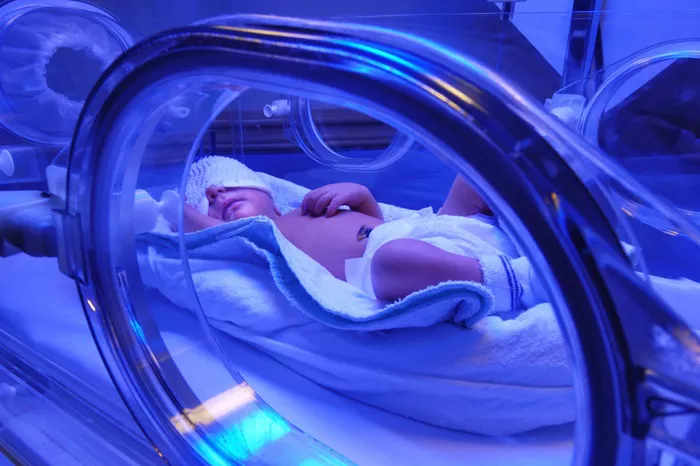Phototherapy is a crucial treatment used in neonatal care, primarily for addressing jaundice in newborns. This article will delve into what phototherapy is, how it works, its applications, and its effectiveness in treating newborns.
What is Phototherapy?
Phototherapy is a medical treatment that uses light to treat various conditions in newborns. The primary application of phototherapy is to manage neonatal jaundice, a common condition in which a baby’s skin and eyes turn yellow due to excess bilirubin in the blood.
How Does Phototherapy Work?
Phototherapy works by using light to break down bilirubin in the baby’s blood. Bilirubin is a yellow substance produced from the normal breakdown of red blood cells. The liver usually processes bilirubin, but in newborns, especially those born prematurely or with liver immaturity, this process can be inefficient.
The light used in phototherapy helps convert bilirubin into a water-soluble form that can be easily excreted by the baby’s liver and kidneys.
Types of Phototherapy
Conventional Phototherapy:
This involves exposing the baby to fluorescent or halogen lights in a specialized unit. The baby is placed under the light, typically in a warm incubator or open bassinet. The light is directed towards the baby, usually from above.
Fiberoptic Phototherapy:
This method uses a special blanket or pad that contains fiberoptic cables. The light is delivered through these cables, which are placed against the baby’s skin. Fiberoptic phototherapy is less invasive and allows more mobility for the baby compared to conventional methods.
Dual Phototherapy:
This combines conventional and fiberoptic phototherapy to maximize the effectiveness of the treatment.
Indications for Phototherapy
Phototherapy is mainly indicated for:
Neonatal Jaundice: The most common reason for phototherapy is to treat jaundice caused by high levels of bilirubin. It is especially necessary when bilirubin levels are higher than what the newborn’s liver can handle.
Hemolytic Disease of the Newborn: This condition occurs when the mother’s antibodies attack the baby’s red blood cells, leading to increased bilirubin production and jaundice.
Premature Infants: Premature babies often have immature liver function, making them more susceptible to jaundice that may require phototherapy.
Certain Infections: Some infections can also lead to elevated bilirubin levels, making phototherapy a necessary treatment option.
Benefits of Phototherapy
Effective Reduction of Bilirubin Levels:
Phototherapy significantly reduces bilirubin levels in the blood, which helps to alleviate jaundice and prevent complications such as kernicterus (a form of brain damage caused by very high bilirubin levels).
Non-Invasive:
It is a non-invasive procedure, making it a safer alternative compared to other methods of treatment.
Rapid Results:
Phototherapy often shows a quick response in lowering bilirubin levels, allowing for timely treatment and discharge from the hospital.
SEE ALSO: Why Do Newborns Smile in Their Sleep?
Low Risk of Complications:
The risk of complications from phototherapy is generally low, especially when monitored properly.
Procedure for Phototherapy
Preparation:
The baby is placed in an incubator or open bassinet with the phototherapy lights. If using fiberoptic phototherapy, the blanket or pad is positioned under the baby.
Monitoring:
The baby’s bilirubin levels are monitored regularly through blood tests. Vital signs, such as temperature and heart rate, are also closely observed.
Protective Measures:
To prevent damage to the baby’s eyes, they are covered with special eye shields. The baby’s genitalia may be protected to avoid exposure to light.
Duration:
The length of phototherapy treatment varies depending on the severity of jaundice. It may last from several hours to a few days.
Feeding and Care:
During phototherapy, the baby can still be fed and handled. Regular feeding helps in the elimination of bilirubin through stool and urine.
Potential Side Effects
While phototherapy is generally safe, there are potential side effects to be aware of:
Skin Rash: Some babies may develop a rash or dryness on their skin from exposure to the light.
Diarrhea: Increased bilirubin breakdown can lead to diarrhea, which requires monitoring to prevent dehydration.
Temperature Fluctuations: The light can affect the baby’s body temperature, so it’s important to maintain appropriate warmth.
Dehydration: Increased fluid loss through the skin can lead to dehydration, which needs to be managed by ensuring adequate hydration.
Retinal Damage: Although rare, prolonged exposure to intense light can potentially cause retinal damage, which is why eye protection is used.
Effectiveness of Phototherapy
Phototherapy is highly effective in treating jaundice in newborns. Studies show that it can reduce bilirubin levels rapidly and significantly, often resulting in improved conditions and faster recovery.
The effectiveness of phototherapy depends on several factors, including:
Timing of Initiation:
Early initiation of phototherapy often leads to better outcomes and faster bilirubin reduction.
Intensity of Light:
Higher intensity light, as used in some modern phototherapy units, can be more effective in lowering bilirubin levels.
Underlying Cause:
The effectiveness may vary depending on the underlying cause of jaundice. For instance, jaundice due to hemolytic disease may require additional treatments.
Duration and Frequency:
Adhering to the recommended duration and frequency of phototherapy sessions is crucial for achieving the desired results.
Follow-Up and Monitoring
After phototherapy, it’s important to monitor the baby’s bilirubin levels to ensure they remain within a safe range. Follow-up appointments with the pediatrician are scheduled to assess the baby’s progress and determine if any further treatment is needed.
Parents are advised to keep a close watch on their baby’s overall health, including feeding patterns and bowel movements, to ensure continued well-being.
Conclusion
Phototherapy is a valuable and effective treatment for managing jaundice in newborns. By utilizing light to break down excess bilirubin, it helps to alleviate the condition and prevent potential complications. Understanding the process, benefits, and potential side effects of phototherapy can help parents and caregivers make informed decisions about their baby’s care.
As with any medical treatment, close monitoring and adherence to medical advice are essential to ensure the best outcomes for the newborn. With proper management and care, most babies respond well to phototherapy and recover quickly from jaundice.


